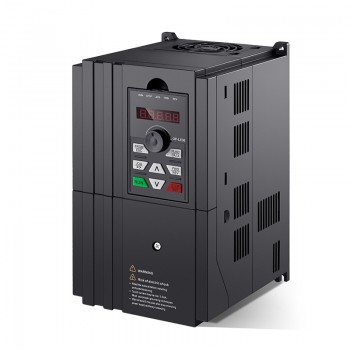1.What is a variable frequency drive?
A variable frequency drive is a power electronic device that is mainly used to control the operation of motors, especially induction motors. It achieves precise control of the motor speed by changing the power frequency and voltage supplied to the motor. The core functions of VFD include energy saving, improving equipment performance, extending equipment life, and reducing maintenance costs.

2.Working principle of variable frequency drive
The working principle of VFD is based on the change of power supply voltage and frequency. It mainly consists of three parts: rectification part, filtering part and switch or inverter part. The rectification part converts the three-phase AC signal into a single DC power rail, the filtering part removes the AC ripple through large capacitors and inductors to provide a smooth DC output, and finally the switch or inverter part inverts the DC power into AC power to control the speed of the motor.
3.Functions of variable frequency drives
1.Speed regulation function: The variable frequency drive achieves stepless speed regulation of the motor by changing the frequency of the AC power. This means that the speed of the motor can be adjusted at any time according to production needs, whether it is fast start or slow operation, it can be easily achieved.
2.Energy-saving function: The variable frequency drive can adjust the speed of the motor according to the load demand, prevent the motor from running at the rated speed for a long time and causing waste, thereby reducing energy consumption. By controlling the running speed of the motor, energy can be saved while meeting production requirements.
3.Automatic control: The variable frequency drive is used together with the sensor to realize closed-loop control, automatically adjust the running state of the motor according to the feedback signal and the set control program, and realize automatic control.
4.Motor protection: The variable frequency drive has protection functions such as overcurrent, overload, and overvoltage. It can automatically cut off the power supply when the motor is abnormal, avoid motor damage, and protect the safety of equipment and systems.
5.Noise reduction and vibration reduction: The variable frequency drive can reduce the noise and vibration of the motor during operation and improve the stability and reliability of the equipment.
6.Increase the life of the motor: By controlling the start and stop, speed and load parameters of the motor, the variable frequency drive can extend the service life of the motor and reduce unnecessary wear and damage.
7.Self-diagnosis function: The variable frequency drive can automatically detect the running state and faults of the motor and improve the reliability and stability of the equipment.

4.Main application scenarios of variable frequency drives
1.Fan and pump loads: Variable frequency drives control air volume or flow by adjusting the motor speed to achieve energy saving. For example, many water companies' water pumps, chemical pumps in the chemical and fertilizer industries, etc. use variable frequency speed regulation, which has significant effects.
2.Household appliances: Variable frequency air conditioners, refrigerators and other equipment use variable frequency drives to adjust the cooling capacity and improve energy saving effects. For example, variable frequency air conditioners can effectively reduce energy consumption during peak power consumption in summer.
3.Production equipment: Rolling mills, elevators and other equipment require precise control of motor speed to achieve automation and efficient production. For example, rolling mills in the metallurgical industry use AC-DC-AC inverters to meet the needs of low-frequency load starting, synchronous operation between racks, constant tension control, etc..
4.Precision equipment: CNC machine tools, robots and other equipment require high-precision control of motor speed and torque to achieve precise motion control and processing. For example, roller loads in the steel and metallurgical industry use AC motor variable frequency control to improve equipment reliability and stability.
5.Heavy industry: Water treatment, chemical industry, metal processing and other fields use variable frequency drives to save energy, reduce noise and improve equipment operation stability. For example, chemical pumps in the chemical industry and mud pumps in the non-ferrous metal industry use variable frequency speed regulation with good results.
6.Other industry applications: Variable frequency drives are also widely used in large industrial rotary kilns (converters) such as metallurgy, building materials, caustic soda, as well as crushers, ball mills and other loads. For example, crushers and ball mills used in metallurgy, mining and building materials have significant effects after using variable frequency.
Posted
Feb 06 2025, 12:39 AM
by
Randy45